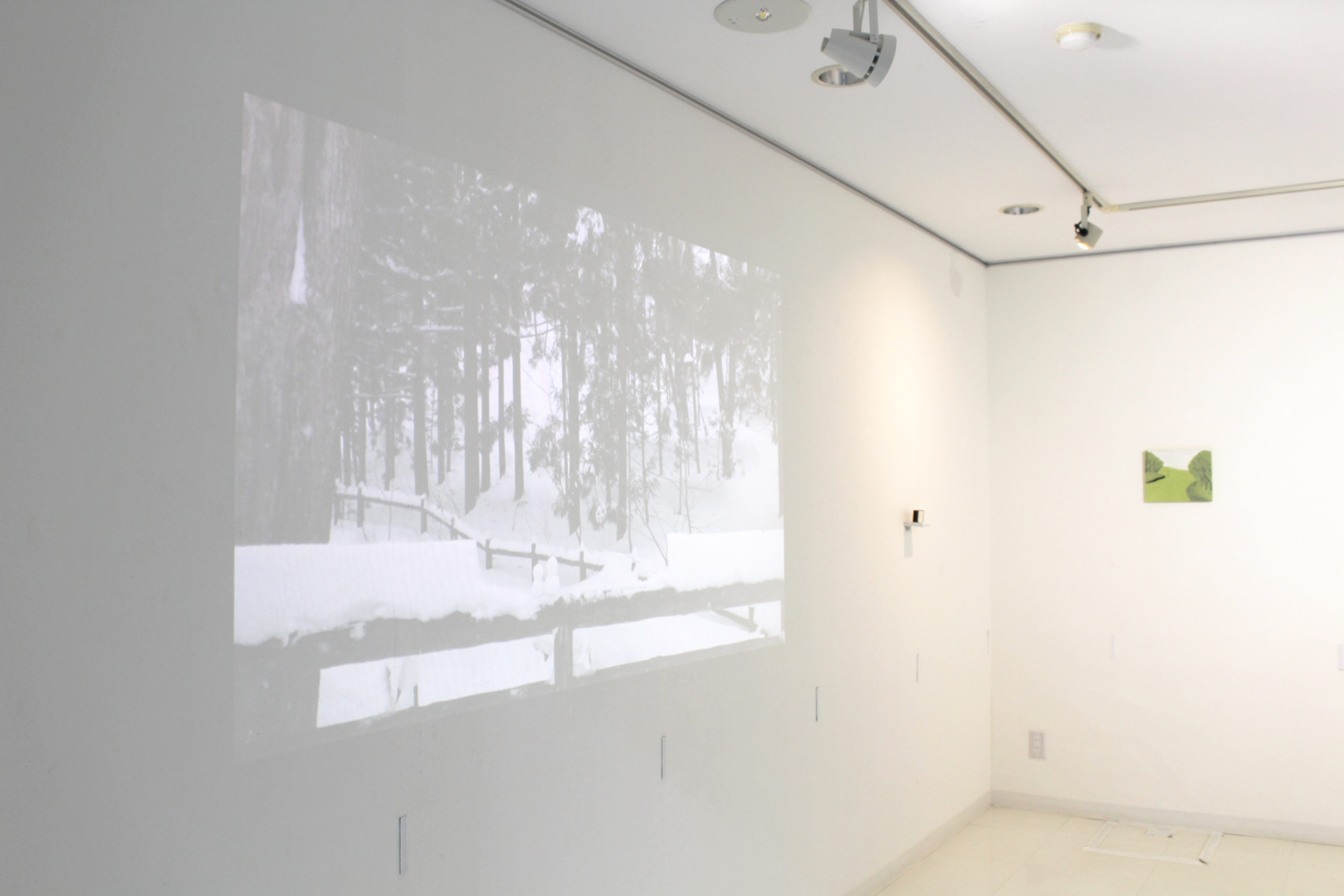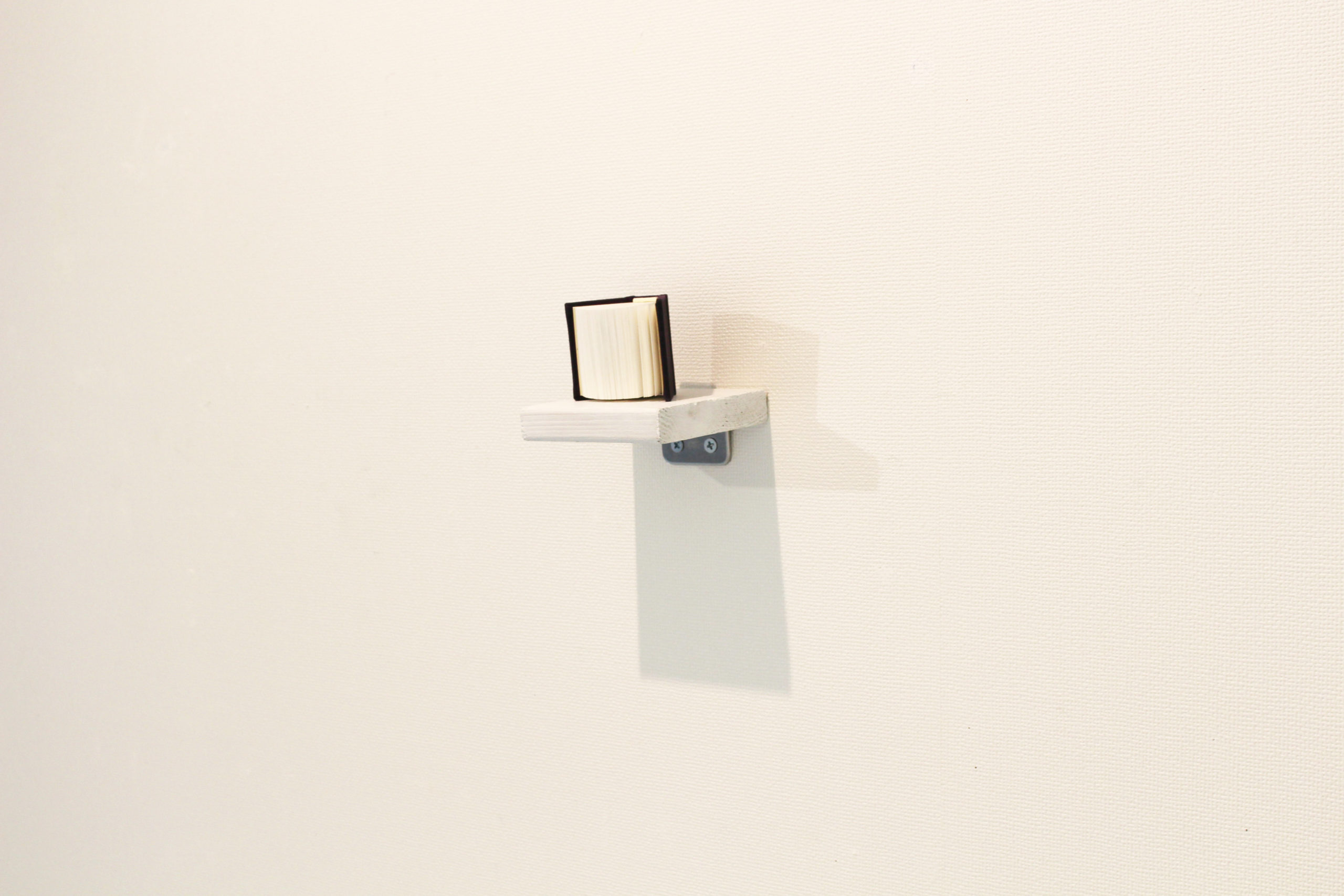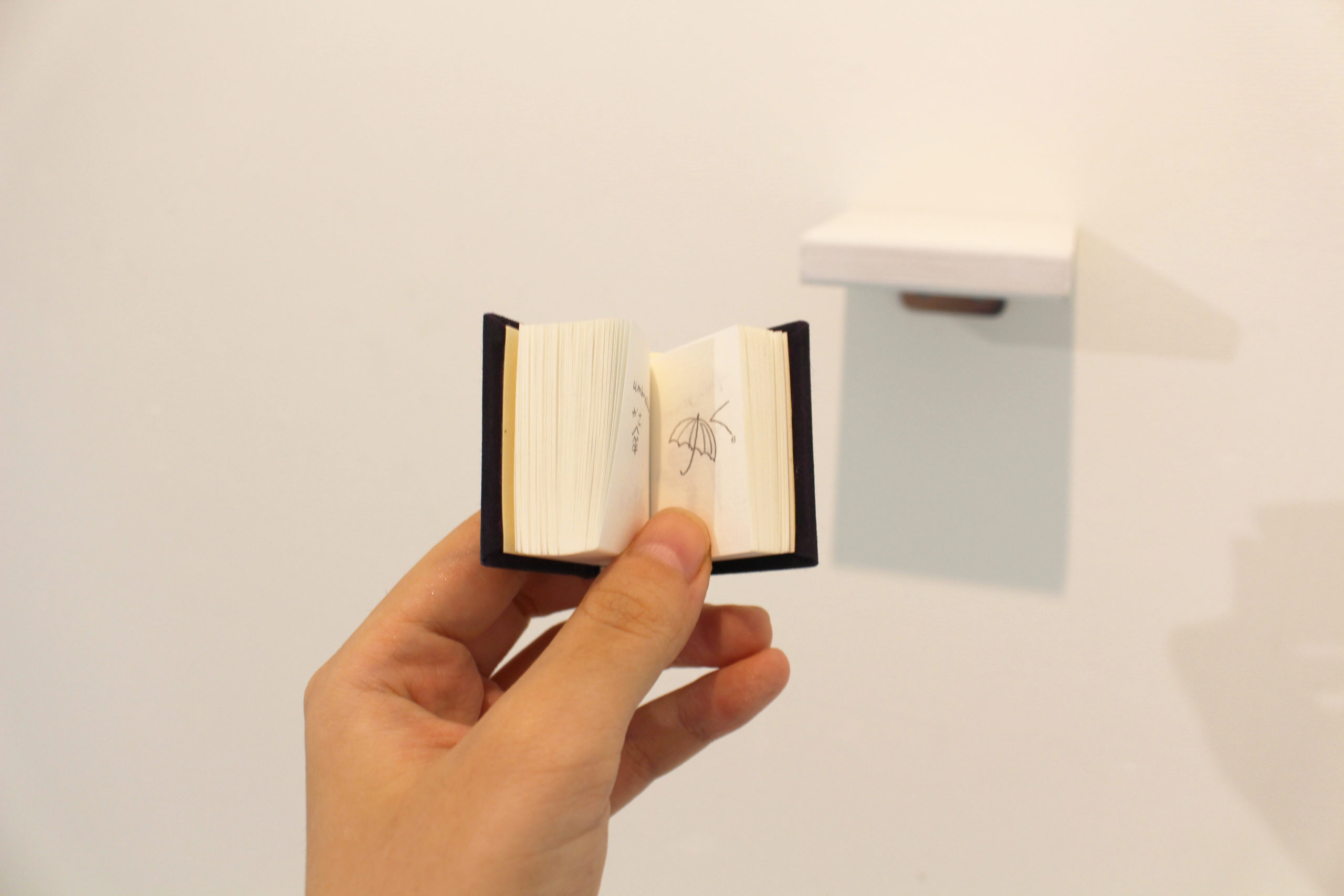
Hello. This is the digest for the 2/2 of Tenjinyama's artist interview with Hong Kong artist 黃美諺 (Wong Mei Yin Hazel). If you're happened to be here skipping the first half, you can read one here.
In this article, Hazel and one of our staff explored together at the artist's solo show 'Sprout-Colored Glasses' (July 14th - August 1st, 2021 / Sapporo Tenjinyama Art Studio), throwing back details about her second stay with Tenjinyama Art Studio, which started in January 2021. If you'd like the full texts, you can open the complete PDF for the 2/2 here.
Index for the 2/2 in digest
-
- on the artist's second stay with Tenjinyama (in 2021)
- presentation outside the residency in 2021
- inhouse solo show 'Sprout-Colored Glasses'
- in the gallery #1, section "paintings"
- in the gallery #2, section "glasses"
- in the gallery #3, section "zines"
- "emotions of painting"
- final thoughts
● on the artist's second stay with Tenjinyama (in 2021)
-- Can you tell us specifically about your second stay? How has it been?
黃美諺 (HW, hereafter) : My second stay was from January to July --
-- Six months. That was long, wasn’t that?
HW: Quite long. And I hadn't imagined [about the opportunity] before because I actually came here by chance. I mean I planned, but I was confirmed just last November. So, for me, everything was so sudden.
*
HW: Have you seen the video [which was presented in the show “Sprout-colored Glasses”]?
-- Yes.
HW: It’s like a foreigner's eyes to keep exploring to see… Even though it’s just snow falling, I can sit back and look at it for so long. I know for you guys maybe it sounds crazy because you’ve always seen it in Hokkaido, but… most of it [*the scenery in Hokkaido] really shocked me out. How it’s been… Because I had to go to school and I also had some projects in Hong Kong, actually it’s been quite busy, but I always try to balance. I want to balance all the things; I want to have a good community here. I live here for one year, so I can’t ignore everything here. I want to focus on the life here, but I also need to do the Hong Kong works to stay in the connection with Hong Kong and to earn money. Study [at a language school], for me, is not the priority, but it helps me sometimes to learn the culture and to talk to people. I know that in Tenjinyama, most of you speak English with me, but on the street, no one does. So, sometimes, for simple conversations, I can still understand or use Japanese to communicate, so [that is] good this time.
-- Okay.
HW: About artmaking… I have a very deep feeling for it because I’ve seen so many new things here and they gave me a lot of inspiration. Also, a lot of time and space for me to focus on the works I do, this time. In Hong Kong, I always have so many people to meet. I have work, and so many things I have to do there, and I cannot concentrate on making my work. The last time I painted on an actual wood board was two or three years ago -- because after that, they had a demonstration. And I just didn’t want to paint. After my last time in Tenjinyama, I couldn’t paint, like, totally. I just felt, “What’s the point of making paintings?” Then I started making zines because that way I can publish them and tell stories to many people. Then, this time, it was a chance for me to be back at painting. And I’m really happy -- actually, I love painting.
*
-- You said you’ve restarted painting after you came back to Sapporo. How did that affect your practice?
HW: Because I always separate zines and paintings, zines for me are really a communication with audience. So, I make them very simple to help people with understanding it. But, for paintings, I don’t have to care about anyone. Painting, for me, is just for myself. I paint it, and it’s done. Sometimes, if people like it, or if I can sell it, it’s a bonus for me, but I’m not asking people to understand anything when they look at the painting. But this time, I made a lot of paintings. Some of them are already sent to an exhibition in Hong Kong. And some people in Hong Kong, my friends, told me that they are happy to see me painting again, and that they can feel the difference between this year’s paintings and the ones from two to three years ago. They say they are so different. They can see it. I can’t see it, so I don’t know, but I see that’s interesting.
-- Have they told you how those paintings are different?
HW: They think my paintings before are a little more complicated, but this time, they think things are simpler. They say they are so different, but I don’t know.
● presentation outside the residency in 2021
-- Now, let’s talk about the exhibition. Can you please tell us about the shows/exhibitions/projects you’ve been involved in during this residency, outside of this facility?
HW: Before this past New Year’s Day, I had a little freelance works, just for small events and designs, but maybe because the Covid situation is getting better in Hong Kong, art shows and events there are, now, like a boom. I think it’s also because it’s a pause period for demonstration now, and so people have so many things to say. That’s why they want to create art events and exhibitions now. And I think that’s why I have so many projects I’ve got to involved in over in Hong Kong last six months.
● in-house solo show 'Sprout-Colored Glasses'
-- Can you please tell us about your solo show at Tenjinyama? The title is very interesting, first of all. What does it mean?
HW: Yes, it’s called ‘Sprout-colored Glasses’. Have you ever heard of this thing called “rose-colored glasses”?
-- No, I haven’t.
HW: You can google it.
-- (While googling “rose-colored glasses”) Is that a song?
HW: No, it’s a phrase. It means, when you wear the rose-colored glasses, you will see the world very beautifully and everything seems good. It’s a little naïve because you’re ignoring the reality when this happens.
-- I see…
HW: It can go both good way and bad way, just depends. As I’ve said, I always like to see the world like a foreigner, an outsider. And this time, I felt really like an outsider. I felt like always wearing the glasses to see the world filtered. And this color [*sprout color], actually, is the spring color in Sapporo, I think. Of, around April or May. During that period, I always saw this color and so I thought, “Maybe I can just change the word ‘rose’ because rose doesn’t belong to me while this color [does]”, so I changed the color. It’s like a Sapporo color to me. When I’m wearing those glasses, I’m in a beautiful world, but I know of course, not actually. Even though in Sapporo, we still have many things, not just those that are beautiful. We still have problems, but because I’m a foreigner, I know only a little bit of it. Especially I’m out of Hong Kong now, everything here is so beautiful. It’s so good. I’m like wearing the glasses and ignore the reality.
● in the gallery #1, section "paintings"
HW: These paintings, they are actually friends.
-- Friends.
HW: Everyday I have to check the news about Hong Kong and that made me feel daunting, but everything I see outside – like, this is a fox, I saw a fox -- was very pretty. So, I thought, I always get the contrast. That’s what these works are about.
-- I see.
HW: Also, this manga. This is a scene from Hakodate, actually. After the sight-seeing, I just stayed there and saw many young people running down the mountain. They looked so happy – they were the happy ones. They were all so young and it was good. But because of their running, the gesture, I remembered the young people running from the protest in Hong Kong. Even though I see so many things here, both good and bad, I always remember things in Hong Kong and make comparison. “Why? Why Hong Kong is like this and here it’s so different?” All these “Why? Why? Why?” … they made me have so many ideas and inspiration.
-- Interesting.
HW: But some of them are just small thinking about the city.
-- Okay. Now I remember you’ve explained in the first interview how you’ve been attracted to small things.
HW: Yes, yes. This is just a tea pot in front of me and this is the first sakura, people… Everything is so small, but I believe small things are essential in our life because when they are connected together, it becomes our life.
*
HW: In this part are paintings. Still very small because my paintings are very small. They are about life and of my imagination from this city.
-- I see… Oh, these look like the views at Tenjinyama Park.
HW: Yes, they are, so that people can notice [laughing] But actually, there are so many things [in the paintings]! In my works I choose the things I like and keep them. Mostly the buildings [are edited out], because I don’t like to paint them… I don’t know why, maybe they are too artificial?
-- So, nature drives you more to paint?
HW: Yes.

● in the gallery #2, section "glasses"
HW: [...] this [*movie piece called ‘megane’] is very casual work. I didn’t expect to make this as a work first.
-- I understand, from that you’ve said you’d always worked in two dimensional medium. Is this the first time—
HW: Yes, this is my first time. But, when I paint, or before I paint, most of the time I take a lot of photos or go different places to explore and see. So, this is actually my visions of the cities, from winter to summer. I also liked when Mami [*Mami Odai, AIR Director at Tenjinyama] called it a video diary. I thought, “This term is quite good” because for me, this is not a very serious work and I just wanted to share the world I see, or how I vision.
-- Through your glasses?
HW: Yes, yes. Some parts of it became my paintings and drawings. Maybe you can find this scene from this part, and this from that…
-- Yes, yes.
HW: So, that’s why I call it “megane”. And these are just some doodles. Doodle dictionary.
-- Okay, then these two [pieces from the section “glasses”] are like sketches?
HW: Hmm, maybe more like initials. Very random. Very casual. Because I am not a video artist. It’s just that I always take so many photos.



● in the gallery #3, section "zines"
HW: This is otto. I do it with my friend. This issue was at the artbook fair in Hong Kong around February. I had it printed in Hong Kong.
-- Ah! The one you said you’d tried lithograph for?
HW: Yes, yes! Because I like that printing method so much. Lithograph. My friend printed it and then I received it in March to show it here because I did it here.
-- How long did it take you to finish this?
HW: Actually, very fast. If I concentrate, I can do it within two weeks. Like most of my paintings –I do them [*paintings] within two days.
-- That’s insane!
● "emotions of painting"
HW: My thinking is what always takes so long, but I have to paint very fast because, I have to confirm that my feeling is lasted for the whole painting period. That’s why I choose the wood board and acrylic paints. I tried oil painting before, but it was totally not okay for me. My emotion didn’t last for such a long painting period. I think there are “emotions of painting”. When you do the painting, it’s very important. It will affect your paintings. But, some of my friends, they also do paintings, but they don’t have this kind of concern. It’s totally different. I think it just depends on people and character.
-- It’s more like “your method”?
HW: Yes, yes. So, when I have an idea, I can do it so fast. Everything. I have to do it so fast. This manga has some scenes from the movie. I will keep drawing one thing if I’m still interested in it. I think, this one -- I will keep working on it and make a new one in Hong Kong next year.
● final thoughts
-- Okay. I think that’s all for now for this show. Now, what is your next move?
HW: My next move? I will move out of Tenjinyama…
-- You’re literally moving!
HW: I think it’s one, independent living. Because, as I said, this is my first time living alone [1]. And also, because I already finished my projects in Hong Kong and Tenjinyama, I can now finally focus on what I really wanted to do after them. Maybe I want to explore more in Sapporo or Hokkaido and try to enjoy the freedom. And see if there’s any opportunity for my art here.
-- I see. I think that is all for the second part. Thank you very much!
[1] According to the artist, it is common for younger adults in Hong Kong to live with their parents or roommates and never live on their own to afford their high cost of living.
―――――――
Artist Wong Mei Yin Hazel has a soft spoken personality. Her politeness is almost other-worldly. And with the gaze she holds towards her surroundings, exceptionally keen and insightful, she cuts deep into the emotional truths of humans but with a nuanced touch. After the interview, I came to realize that it could be such nuance in her touch, heavily interconnected to histories of Hong Kong as well as to the Japanese aesthetics of subtleness, that speaks to an essence of humanity of emotional nomads that we, to some degree, all are.
It is a great distress that this interview was only successful with exploring a glimpse of the artist's career and practice. For those who may be looking for better visual understanding of Hazel's work, her artist website should provide a preferable navigation.

[image description] An avocado seed deliberately growing its roots in a bin at the window at Tenjinyama office. The seed and the bin originally belonged to the artist Wong Mei Yin Hazel, but was temporarily left at the office at the moment of the photo shoot. They were given back to the artist shortly after.
(Chinatsu Igarashi, staff at Sapporo Tenjinyama Art Studio)